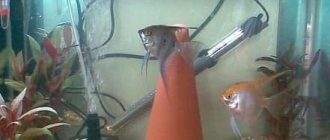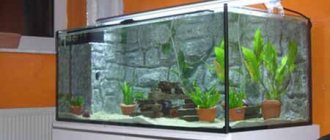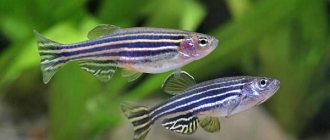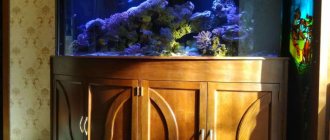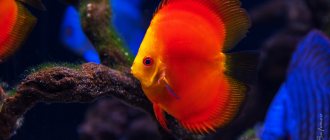Hello to all readers of my blog! I present to your attention another publication about breeding aquarium fish. I think that sooner or later one of you will decide to breed your favorite aquarium fish for yourself, and then my publication will be at hand, which may contain the most valuable advice at that time.
Or maybe not! Since my publication is just a small drop in the huge world of aquarium farming where I give advice on breeding only the most simple and well-known species of fish, but these tips are my personal and well-tested, and not taken from books as many authors of aquarium sites do posing as experienced aquarists.
The simplest spawning fish species
The simplest and most well-known spawning and viviparous fish species include: guppies, mollies, swordtails, barbs, zebrafish, ternets, gourami, goldfish and cardinal fish. And this list is far from complete. Why are only these types of fish, and not, for example, discus, so common among aquarists?
Yes, because these types of fish are easy to both keep and breed and therefore have gained great fame and popularity. Due to their ease of keeping and breeding, most aquarium fish are not bought in markets and stores, but are passed from aquarist to aquarist just like that, in exchange for other fish or for money.
Types of spawning aquariums
There are several types of spawning aquariums. The basis for their classification is, of course, the type of fish for which the aquarium is intended to breed. The most common types of such aquariums include:
1) For viviparous fish. The volume of such an aquarium should be at least 15 liters. The use of a variety of aquatic plants is desirable, and the most suitable plant is moss, due to its ability to perfectly imitate the natural conditions in which the female will feel comfortable. A state of stress can lead to the birth of underdeveloped, and therefore incapable of life, fry. There should not be females and males inside the aquarium at the same time; this factor is important for increasing survival.
2) For fish that scatter eggs. The volume can be from 10 to 200 liters, depending on the type of fish that is planned to be bred. Of course, large fish require a larger container to reproduce comfortably. There is no need to place plants in the aquarium and fill the bottom with soil. However, after spawning, the eggs need protection from being eaten in the form of a separator net, which is placed at a distance of 3 centimeters from the bottom. The cells of this mesh should not be more than 3 millimeters, this will not allow adult individuals to reach the eggs.
3) For fish that stick eggs. Fish belonging to the characin family have sticky eggs. The process of breeding such fish is greatly facilitated by the fact that adults do not eat eggs or fry. An aquarium capacity that is too large is not recommended; for large representatives a volume of up to 50 liters is required. It is advisable to place plants, especially floating types or with long roots, but there is no need for soil at all. Plants with small leaves will also contribute to more successful spawning.
Selection of manufacturers
Before you start breeding fish, you need to pay attention to their age and health. Many inexperienced aquarists, having not learned how to properly keep fish, are already trying to breed them. Fish in the state of “NO FAT, I WISH I WOULD ALIVE” will never reproduce.
Proper keeping of fish is the key to success in their breeding. What is needed to properly keep fish? For proper keeping of fish, it is vitally important: do not keep the fish in an overcrowded spacious aquarium with a stable biological balance, be sure to feed the fish with live food, and the water temperature and daylight hours must correspond to a particular species.
Preparing for spawning
Young fish that have reached sexual maturity are selected for spawning and for several days (maybe one week) males and females are kept separately. At this time, the separated fish are fed with live food to ripen their eggs and milk. If there are no free aquariums, you can place fish, for example, males in the spawning tank, leaving only females in the general aquarium, or vice versa.
If you keep fish in hard water, then in the spawning tank you need to soften it by reducing the carbonate hardness and diluting it with: boiled water, melted snow or rain water. How to properly soften water, read my publication “How to soften water in an aquarium.” Soft water will not only stimulate spawning since most tropical fish spawn during the rainy season, but will also significantly increase the number of fertilized eggs.
However, in zebrafish and barbs you can get a fairly large yield of fry without water softening, which cannot be said, for example, about neon fish where without water softening you will not get a single fertilized egg. Very often, in zebrafish and barbs, spawning can occur directly in a common aquarium and without any preparation.
As a rule, such spawnings occur in the morning hours after evening cleaning and replacing part of the water with fresh water, which serves as a stimulating impetus for the start of spawning. In some cases, an increase in water temperature of 1-2° degrees can serve as an impetus for the start of spawning. In this case, spawning fish can be caught and placed in a spawning tank equipped with: a protective net from eating eggs, as well as a lamp, a compressor and a heater where spawning will safely continue.
As a protective net, I always use tangled threads of synthetic rope laid on the bottom of the spawning tank and pressed with stones. The eggs that fall between the threads become out of reach of the fish. This material for protecting eggs is also convenient because it can be laid in aquariums whose bottoms have different areas.
If the fish are placed tightly enough in such a net, they will not get tangled, which cannot be said about fishing line, which I do not recommend using as a protective material from eating eggs. In order to protect the eggs from being eaten, you can use small-leaved floating plants placed on the bottom and pressed with stones: Hornwort, Cirrus, etc.
Note: earlier, when the Hornwort plant grew in abundance in my aquarium, I used it in the spawning aquarium as a net for protecting eggs. The plant laid on the bottom and pressed with small stones not only saved the eggs, but also to some extent gave the image of a natural spawning ground where the fish always feel more calm and confident.
Spawning methods
Spawning can occur differently for each type of fish. It is necessary to take into account their individual characteristics in order to achieve good results in breeding the desired fish.
On the stone
Such fish are accustomed to laying eggs on the flat surface of a stone or other hard and even substrate. Instead of a stone, you can use a dark saucer. After spawning, it is better to incubate the eggs in a separate container with water from the spawning tank, provide good aeration there and add disinfectants. When you see a hatching, you can direct a stream of water onto the eggs, and only the missing white eggs will remain on the stone.
On the leaves
A fish like the angelfish prefers to spawn on a leaf. When preparing artificial incubation, a stainless steel plate or artificial plastic is used instead of a sheet. Antibiotics and synthetic dyes are added to the water. The water level should be about 10 cm. A sprayer is installed near the masonry.
In a foam nest
Cockerels usually spawn in this interesting way. The aquarium needs to be small; there is no need for shelters, filters or aerators. There is also no need for bright lighting that can scare away growers. To prevent fish from jumping out of the aquarium, cover it with a lid.
The male begins to build a foam nest, swallowing air and spitting out bubbles of saliva in one place. So, a kind of dome of foam rises. The ready female swims up to the call of the male, they clasp each other and the female releases eggs. The father takes care of the eggs, but it is better to remove the female, as she will irritate the male.
On glass
The most popular representative of glass spawning is the Corydoras catfish. This is a rare case when the female takes part in the fertilization of the eggs. The male bends over, and the female swallows milk into her mouth, then she throws a portion of eggs into the pelvic fins and glues them to a clean place. Next, she pours milk from her mouth onto the caviar.
Out of water
The method of spawning out of water is unique, and occurs in fish such as the splashing tetra. Under natural conditions, the fish spawns on leaves and branches of plants above water. And in an aquarium, a cover glass is used for this, where the distance from the water to the glass should be 5 cm. The male can change partners several times, jumping out with them at the same time. Then the male himself takes care of moistening the eggs, wetting them with splashes of water.
To deposit eggs into the incubator, the cover glass is removed and the eggs are shaken off with a feather.
In a common aquarium
This type of spawning can be used when keeping one type of fish, peaceful in nature, like cardinals and palmeri. It is best to fence off a third of the container with a separator net, where Java moss and small-leaved plants are laid out at the bottom of most of it.
Return to content
Clown fish
Spawning tank
The spawning tank should be fairly free. I am not a supporter of small spawning tanks, and certainly not three-liter jars. Think for yourself how many problems you will create for yourself when catching fry from a jar? And this is not as simple as it might seem. When moving fry from a small tank to a large one, it is necessary to take into account the coincidence of temperature and hydrochemical parameters of the water in the jar and the nursery aquarium, changes to which the fry must gradually get used to.
And if this requirement is not met, at best the fish will experience shock, and at worst they will die. The best option, which I myself use, would be a spacious spawning tank, which with the appearance of the fry will also serve as a nursery aquarium. In a spacious spawning tank, the fry do not experience stress and grow quickly, and the fry, which have already grown to the state of juveniles, can be transplanted into a general aquarium by gradually equalizing the water parameters.
Starter feed
If you are raising fish for the first time and decide to feed your fry with commercially produced artificial food, I sincerely ask you not to do this. Well, if you believe advertising more than me and are ready to destroy all your numerous offspring, then be prepared for the fact that you will still have to understand that it is better to learn from the mistakes of others.
Swimming fry need nutritious food, and live food will be nutritious food for them. And no modern food can replace live food, since it is inherent in the fish by instinct and no one is able to cancel this program. The most suitable live starting food is plankton: ciliates, rotifers, cyclops, small daphnia.
Aquarists call this set of aquatic organisms “living dust.” Why is only plankton the best starter food? Yes, because plankton is the very first food for swimming fry in natural conditions. And if you know the existence of natural reservoirs where you can catch plankton in spring and summer, consider that you will not have problems with breeding fish.
In other cases, you will simply need to learn how to raise live food at home. The very first and necessary live starting food is the ciliate slipper. Breeding ciliates at home does not present any difficulties. How to learn how to breed ciliates can be found in my publication “Breeding Ciliates”.
The second valuable and irreplaceable live lump for growing fry will be Daphnia moina. Daphnia moina is distinguished by a high content of nutrients and is unique in that newly born crustaceans can be fed to fry, and large, already grown daphnia is well suited for juveniles and adult fish. Breeding Daphnia moin is very simple. You can learn more in detail from my publication “Daphnia fish food.” Also, if you wish, you can order Daphnia moin breeding from me for breeding at home.
My method of feeding fry
Aquarists' methods of breeding fish and feeding fry may vary, but in all cases the principle of alternating food is similar. For example, I give boiled yolk to the fry that have just swam for the place of the infusoria and immediately release live daphnia. I don’t wash the yolk of the smallest particles (milk), they are eaten by daphnia, and the water in the aquarium remains constantly clear. You can learn how to properly feed fry with yolk from my publication “How to feed fry with yolk.”
For the first 2-3 days, the fry feed on yolk and then switch to daphnia. Fry on live daphnia grow very quickly and do not lag behind in growth at all. The fry willingly eat boiled yolk: barbs, zebrafish, thornets, gourami, goldfish, and this list is far from complete.
Fry that do not eat the yolk should be fed with ciliates and also with a subsequent transition to live daphnia. From the first day of their birth, fry of viviparous fish can be fed with daphnia or vinegar nematode, on which they also grow well. You can find out how to breed a nematode worm in my publication “Breeding a nematode at home.”
Do-it-yourself septic tank
To protect the fish, you can make a fish tank for fry in a community aquarium with your own hands. For this you will need:
- plastic bottle with a volume of 1.5 or 2 liters;
- scissors;
- thick needle;
- lighter.
The bottle is used from under water, after pouring out the contents, removing the label and washing the container. Bottles that previously contained juice or other drinks are not suitable because harmful substances may remain in the walls. The future spawning ground is trimmed, removing 1/3 of the top. In this case, it is necessary to leave a part 5 cm wide - this is the future handle for attaching to the aquarium.
The part left on top is bent in half, and using a lighter, the fold is heated to form a kind of hook. It is important to prevent the plastic from melting. The height of the handle is determined so that the edges of the depositor are above the water level in a large tank.
Now it is necessary to provide aquarium water with access to a homemade fish tank so as not to create a separate aquatic environment. To do this, the spawning tank is pierced with a thick needle so that the sharp tip of the needle comes out. Then the ribbed sharp edges of the holes will not injure the fry, and water from the general aquarium will circulate freely. The punctures are made on one side, and their area should occupy 1/4 of the bottle.
This is where the work ends, and the hand-made spawning tank is ready. Using a handle, the sedimentator is suspended in the wall of the reservoir so that oxygen from the aerator passes through it. This will create favorable conditions for the development and growth of fry. The holes in the depositor must be regularly cleaned of dirt and deposits.
Experienced aquarists claim that this type of spawning tank is much safer and more harmless than mesh tanks. In addition, it will cost the owner of an artificial reservoir completely free, and its production will take only 20–30 minutes. As soon as the spawning ground accepts new residents, all that remains is to do little - feed and care for the young on time, monitoring the development of the babies.
A hatchery for fry in an aquarium will provide small pets with safety and favorable conditions for reproduction and the further formation of offspring, which, with care and proper feeding, will very soon delight the aquarist with their bright colors and graceful movements.
Daylight hours and aquarium orderlies
I don’t turn off the light for the fry in the first two weeks. I believe that it is on these days that the fry especially need food and they should be fed around the clock. As orderlies, as soon as the fry swim, I add several ampullary snails to them. Ampoules clean the bottom of the aquarium from dead eggs and food residues.
And just recently, while breeding pink danios, I discovered another useful orderly and this is the Ancistrus fish. I added a small ancistrus to the fry as soon as they swam.
The peaceful ancistrus did not pay any attention to the tiny fry, but calmly continued to scrape the bottom and walls of the aquarium.
Arrangement
It often happens that fish do not want to reproduce in the spawning area. The reason lies in the insufficient preparation of the container, so you should set up a spawning aquarium according to the principle of simulating the natural habitat of this breed of fish.
It is important to maintain the correct temperature, ensure water filtration and sufficient lighting. A foam filter is used as a spawning filter. A plant - spherical agrophila - will serve as a natural filter and water purifier.
The bottom of the aquarium should not be covered generously with soil or weighed down with an abundance of plants.
Return to content
Goldfish
Preparing the juveniles for transplantation into a community aquarium
Grown-up juveniles (for zebrafish and barbs this can be a period of one month) can be transplanted into a common aquarium. It is very important that young fish are already accustomed to the food that they will receive in a common aquarium. The main food for my fish in a community aquarium is minced meat from grated beef or pork heart, as well as a small addition of white bread and live daphnia moin.
Read how to properly prepare minced meat for feeding fish in my publication “Food for fish, beef heart.” I consider this menu for adult fish quite satisfactory.
Approximately a week before transplanting the fry into a common aquarium, the amount of live food in the diet should be reduced, adding instead minced meat, passed on a fine-mesh grater or scraped from beef or pork heart.
It is necessary that by the time young fish are transplanted into a common aquarium, they can completely do without live daphnia, eating only minced meat.
Caring for fry
When all the eggs are fertilized, the female will decrease in volume and her color will become pale. The fish change their behavior and begin to huddle towards the walls of the tank. The eggs are transparent, scattered on the substrate, gradually all the eggs settle under it.
Neon crumbs hatching from caviar.
From this moment on, adult neons pose a threat to their offspring, and therefore they need to be placed back in the aquarium. The spawning tank with eggs is placed in a dark place. Light is destructive both for eggs and for fry, which at first do not see anything.
For better control over the eggs, it is recommended to remove the substrate by shaking it thoroughly. It is important to remove dead eggs immediately. They can be distinguished by their pale color.
The eggs develop within 5 days, the fry are born on 3-4 days. To protect them from damage by fungus, which causes a decline in offspring, it is recommended to add special preparations to the water.
It is necessary to ensure that a film does not form on the surface of the water, which blocks the access of oxygen to small neons. Equipping a spawning tank with filters is strictly prohibited. Water hardness changes gradually - no more than 1 glass per day.
Feeding a new generation of neons is a complex process. The food is poured into only one area of the aquarium, which needs to be illuminated. The first food is ciliates. After 3-5 days, cyclops, rotifers and artemia nauplii can be introduced into the diet. After 1 month or from the moment when bright stripes appear in the color of the neons, they can be gradually transferred to adult food.
You can put fish in a common tank at the age of 1.5 months, when they are already strong enough.
You can also create a neon cloud in your aquarium, because the propagation of neons is not too troublesome for the owner!
Breeding neons in captivity is a troublesome task, but it is quite feasible if you follow all the rules and recommendations. Timely selection of a pair of mature individuals, organization of a spawning ground and further care of the fry will contribute to the regular production of offspring from these unusual, colorful inhabitants of the aquarium.
